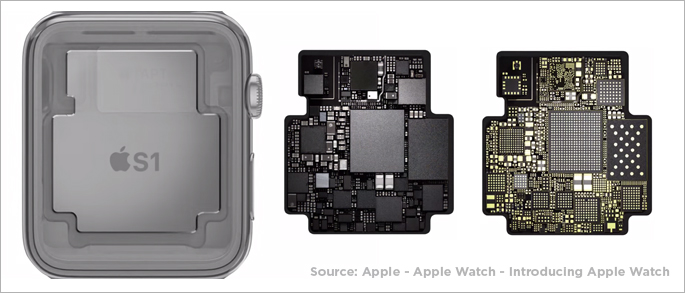Inside the Apple Watch
 Apple is finally initiating the production phase for the Apple Watch. The much awaited device is slated for release sometime in 2015, and this new development means we might hope for a definite release date soon.
Apple is finally initiating the production phase for the Apple Watch. The much awaited device is slated for release sometime in 2015, and this new development means we might hope for a definite release date soon.
Although the Apple Watch took a fair amount of stage time at Apple’s big reveal of the iPhone 6 and 6 Plus, the technology that this device will integrate has been object of some speculation, especially due to battery concerns, one of Apple’s major priorities.
The S1 chip powering the watch has been introduced by Apple as more than just a processor, it is the actual watch, a comprehensive SiP, or “System in Package”, which includes memory storage, wireless connectivity, central processing unit, and every sensor that is part of the product. this also includes the NFC sensor which can be used to process purchases through Apple Pay, as well as control other devices, like Apple TV, or HealthKit-compatible products.
The SiP is also filled in special resin, for durability. The SiP configuration might also partly explain why the large number of units to be manufactured. SiP’s cannot be taken apart, upgraded or repaired, as the filler agent can’t be easily dissolved and separated from the embedded circuit.
The obvious advantage of an SiP, however, is durability and protection from the elements, like water, dust and to some degree, even high or low temperature, depending on the molecular composition of the filling agent. Such protection of course does not include external peripherals, such as the side dial, the touchscreen and any other sensors embedded in plain view, where creases and points of entry are likely to exist.
SiP circuits are actually more common than it may seem. Some inspired by Arduino board designs, credit card-sized all-in-one computers with limited, yet comprehensive capabilities are beginning to surface, mainly for the hobbyist system builder. Not all SiP circuits are embedded in dyes or resins, which is a practice that requires a system to operate at considerably low temperatures, to avoid the system to burn up in a polymeric goo.
The S1 chip is probably the smallest SiP commercial circuit board, optimized to operate at a very low voltage, it makes perfect sense that it would be embedded in a protective coating, which increases durability and the life of the device.
Apple is showing a tremendous amount of confidence in the product, for which the company has asked suppliers to ramp up production with a goal of 30 to 40 million units. Apple’s latest focus on China seems to be also corroborated by Angela Ahrendts, Apple's senior vice president of retail and online stores, who mentioned a potential release date after the Chinese New Year, February 19, 2015.